Contributory members are able to log private notes and comments about each site
Sites Anne T has logged. View this log as a table or view the most recent logs from everyone
Leven's Park ringcairn
Date Added: 9th Jun 2015
Site Type: Ring Cairn
Country: England (Cumbria)
Visited: Yes on 4th Jun 2015. My rating: Condition 2 Ambience 4 Access 4

Leven's Park ringcairn submitted by Bladup on 11th Nov 2014. Leven's park (Archers hill) ringcairn.
(View photo, vote or add a comment)
Log Text: Leven's Park/Archer's Hill Ringcairn, Cumbria: This cairn is close to the roundabout where the A590 meets the A591 and A6 just south of Sizergh Castle. My map reading failed, as the junctions were complicated – no proper roundabouts, just adjoining roads with ‘give way’ signs to transfer from one carriageway to the other, which was fun at 5pm with traffic whizzing everywhere as everyone escaped from work to home. After a few wrong turns, eventually we made it onto the minor (brown) road which runs between Sedgwick and Hincaster, stopping at a small car park (enough room for 3-4 cars) outside a stile over a stone wall leading into Leven’s Park. By the stile, a small stream joining the River Kent tumbled over stones downhill and the trees provided welcome shade.
Walking along the dirt track for a couple of hundred yards, the cairn is to your right hand side, not in view from the path, but in a very pleasant spot, next to the River Kent. Between the dirt track and the actual cairn there is a series of four smaller mounds – possibly either cairns in their own right? -but I could find no mention of these anywhere on Pastcape or any other source. We did look for the mentioned field system around the ring cairn, but could find no evidence of it.
Walking round this ring cairn, there are clearly two different rings, which originally intersected, but give the appearance of now being joined into one larger cairn. Trying to capture the two different rings, we headed up the hill to the south west.
Sizergh Settlement
Date Added: 9th Jun 2015
Site Type: Ancient Village or Settlement
Country: England (Cumbria)
Visited: Yes on 4th Jun 2015. My rating: Condition 2 Ambience 4 Access 3
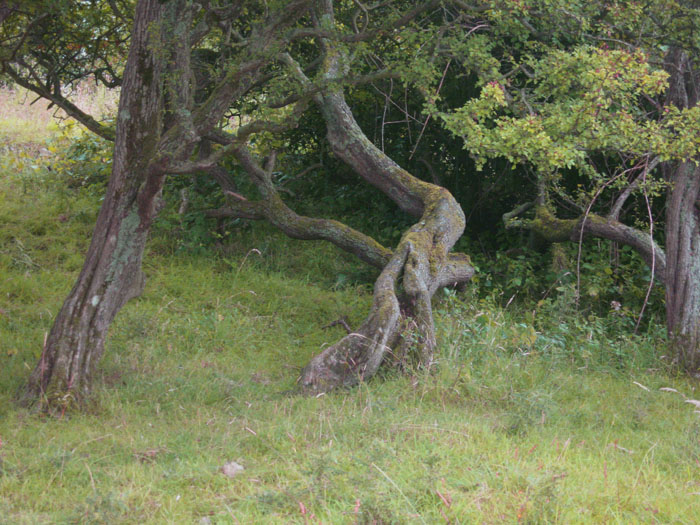
Sizergh Settlement submitted by Alphasmam on 1st Aug 2014. Sizergh Settlement is covered in trees but this tangle of branches adds to the ambience of the place.It is just possible to see the stone outlines in the grass underneath the trees.
(View photo, vote or add a comment)
Log Text: Sizergh Settlement and Cairns, Levens, Cumbria: I’ve spent more time trying to find out more about this intriguing site than all the others we visited today (4th June) as there seems to be so little about it, apart from on the Portal. I’ve tried to visit durhamnature’s ‘archive.org’ to retrieve the “Transactions of the Cumberland Arch Soc” but it’s given me no results (will try again when I’ve got a little more time to spend on this).
Getting here was another challenge for my map-reading skills. It should have been simple enough to reverse directions from Archer’s Hill, returning to the A591 and cutting west towards Levens, but were halted by a ‘no access’ sign. There were plenty of cars coming in the other direction and the road was even two-way, so we took a chance. How wrong could we have been? Almost reaching the end it became apparent that it led onto the dual carriageway heading in the other direction, so a hasty three point turn was made and we ended up following the minor road back past Leven’s Park, through Hincaster and heading back to the A6 to travel north for a short distance before turning off for Levens and heading back east towards Heaves Farm, just north east of Levens.
There was room to park the car by the footpath sign leading up past the western side of Middle Plantation, and we headed up the pleasant grassy track up the hill. To the right hand side there were a couple of gates and footpath signs leading up to the cairns and the circular structure we’d seen on the map. The sign on the first gate told us that the lumps in the grass weren’t grass covering stones as we’d first thought, but ant-hills that were formed on pastures that weren’t mowed. Interesting – never seen these before.
As we walked further up hill, there was a very intriguing (favourite word of the day) circular mound covered in trees (the rest of the fields had no trees at all). As we passed this to our left hand side, the larger of the two cairns rose up at the top of the hillside. There were glorious views over the fells to the north. Heading off to the west, there was a small quarry face with lots of stone chippings. Having photographed this, together with the sheep curled up on the warm limestone, we headed off into the wooded mound. Largely covered in hawthorn trees, it was interesting to navigate the low branches. There was some bedrock peeking through the grass, but also circular structures and also two sides of what had been a rectangular stone building.
Having arranged to meet some friends in Penrith on the way back, we made our way back down the mound to see if we could spot the smaller of the two cairns. Yes, it was there, but rising only 10 to 15 cms above the ground. Our eyes could make out the circular structure but it was difficult to photograph, with no shadows to bring out the mound.
Certainly a lovely spot, and I’m keen to find out more. Getting home and hitting the internet, I ended up getting very confused between this site and a Romano-British Settlement excavated by Oxford Archaeology, but checking the grid references confirmed they were different sites in close proximity. In the end, husband Andrew managed to find the extract below from a free Google book and I found a reference on the British History Online records:Discovering Prehistoric England: A gazetter of prehistoric sites by James Dyer, A Shire Book
Take minor road NE from Levens. The sites are to the N of the road on Sizergh Fell. The site consists of an oval embankment enclosure covering 0.2 hectare, with secondary enclosures to the south. Interior hollows may indicate the sites of hut circles. On the hilltop there is a small round cairn, 7.5 metres across, which contained a collared urn. To the east a further cairn, 9 metres across and 0.9 metres high, covered 5 skeletons."
The Sleepy Sheep, Deepdale
Date Added: 3rd Jun 2015
Site Type: Natural Stone / Erratic / Other Natural Feature
Country: England (County Durham)
Visited: Yes on 2nd Jun 2015. My rating: Condition 4 Ambience 4 Access 4
The Sleepy Sheep, Deepdale submitted by durhamnature on 28th Jun 2012. The Sleepy Sheep, a pink granite glacial erratic beside the River Tees.
(View photo, vote or add a comment)
Log Text: The Sleepy Sheep Stone, Natural Erratic near Barnard Castle: Having decided to go to see Egglestone Abbey, I did a quick trawl on the Portal to see what else was nearby around Barnard Castle. The Red Well and this stone looked intriguing so I printed off the pages, and off we set. [Thanks to Durham Nature for this entry – I’ve since looked up his web site and will dip into this again.]
On the way back from Egglestone Abbey, instead of turning right along The Sills to go over the road bridge over the Tees into Barnard Castle by the castle, we went straight on along Lartington Lane. Whilst it’s a relatively minor road, it is wide but busy along its first part, with Hensall Way peeling off and leading up to HM Young Offenders Institute Deerbolt. Not sure which side of the river the stone was on, we parked on a wider section of the road near Deepdale Cottage, just along from the junction with Henshall Way. We walked back along the narrow pavement to Deepdale footbridge over the river to its northern banks, but drew a blank. From the image from the Portal, the stone was most likely to be on the southern side of the river, so we trekked back over the footbridge (distressingly the wooden sheets across the bridge were all rotten and cracking, and plastic reinforcement had been laid across some parts).
Finding the entrance to the park on the southern banks of the Tees between two cottages, we opened (and closed) the gate and followed the metalled road along the grassy meadow. In a couple of hundred yards I said to Andrew, “either that’s a sheep that’s keeping very still, or it’s the stone.” It was the stone.
The shape of this natural erratic is indeed like a sleeping sheep. Made definitely of red Shap granite, it was so cute! We wondered how on earth it had got there. The Durham Nature web site tells us that there are a number of these erratic in the area, pushed over the Pennines by a glacier during the last ice age. I definitely want to go and find the others at Deepdale and The Mortham Stones.
The location is also very pretty, sleeping between the small road and the river with lush, green grass blowing in the breeze and sheep with their photogenic lambs standing watching what we were doing.
The winds were definitely getting stronger by this time (pity my friends walking from John O’Groats to Lands End who are up around Shap today!) so set off to find The Red Well, then onto Staindrop to find the Anglo Saxon Stone Fragment on the way back.
Red Well, Barnard Castle
Date Added: 7th Jun 2015
Site Type: Holy Well or Sacred Spring
Country: England (County Durham)
Visited: Yes on 2nd Jun 2015. My rating: Condition 4 Ambience 4 Access 4
Red Well, Barnard Castle submitted by durhamnature on 6th Sep 2012. The stone-built shelter and bench seat.
Site in County Durham England
(View photo, vote or add a comment)
Log Text: Red Well, Barnard Castle: Before leaving home late this afternoon, I'd done a quick trawl of what information could be found on the Red Well on the internet, and come across a curious document entitled: “Archaeo-Environment Ltd: South West Durham Heritage Corridor, Volume II Journeys Part 2” in which page 170 (actually page 3 of the document) talked about “Dr. Edwards’ Health Restoring Walk: a route walking from the rail path into the centre of Barnard Castle viewing Dr. Edwards’ natural springs and former railway building”. It then talks about “this circular route leaves the main railway line behind Glaxo and uses existing rights of way (not bridleways) to visit Barnard Castle via the Red Well. Red Well is an attractive 19th century spring located within its own enclosure. It was popularised by Dr. George Edwards who encouraged the residents of Barnard Castle to make use of its health-giving properties ‘Its valuable laxative qualities has, I know, been ascertained. The Red Well was named from the colour of the stain left on the stone over which the mineral spring flowed (Wilkinson 1998, 46). It no longer stains the stone and is not recommended for drinking .... Access to the enclosure today is by an old metal kissing gate which contributes towards local historic character. Inside the enclosure a stone shelter with seat provides views towards Glaxo buildings, but would had originally viewed the railway line. Overgrown with wildflowers rendering the path virtually invisible, the Town Council are only able to mow it once a year. A path was constructed originally in a horseshoe shape around the edge of the enclosure linking the well with the seating area.”
Leaving Barnard Castle along Galgate (the A688 towards Darlington), then peeling off along Harmire Road (the B6278) we drove past the Glaxo buildings. We had difficulty in spotting the footpath signs, as they were either very tiny rectangular shaped or just below the level of the stone walls/shrubs along the sides of the road. In the end we parked along the road into Montalbo Industrial Estate and walked back, crossing (the now busy road, as it was factory closing time), and easily found the footpath which followed the small stream through the grassy meadows on the opposite side of the road.
By this time, the wind was howling and heads down, we started through the field that had a “Bull In Field” notice on the kissing gate (there wasn’t this time, we checked thoroughly before crossing). In the second field we were mugged by the sheep who came baaing and running at us, probably thinking we’d brought them sheep nuts or some other treat. They were disappointed, and when we crossed back, they pointedly ignored us.
A metal kissing gate leads into the enclosure with the Red Well in it. The well/spring certainly has a good output, water streaming from the outlet pipe. The sign inside the stone shelter is curious – there was obviously a ‘battle’ of some kind over the well in the past. Need to find out more, but most of the internet enquiries come up with ‘Red Well Inns/Hotels/Pubs – will find time to look further soon.
Not the best of locations for the well now, with its views over Glaxo Smith Kline buildings and the wind turbines, but on the edge of town and surrounded by meadows and sheep.
We had to really battle the wind going across the meadows back to the car, and were glad of its shelter once we’d arrived. Shame, because whilst it was sunny, the wind meant we didn’t linger at this spot. It was now early evening, so back home, via Staindrop to find the Anglo Saxon Cross fragment.
Edin's Hall
Date Added: 2nd Jun 2015
Site Type: Broch or Nuraghe
Country: Scotland (Scottish Borders)
Visited: Yes on 30th May 2015. My rating: Condition 3 Ambience 4 Access 3
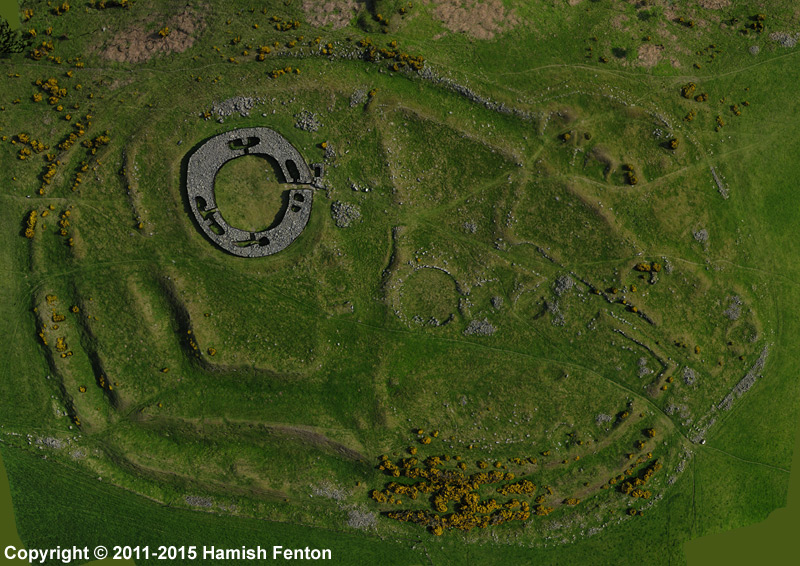
Edin's Hall submitted by h_fenton on 30th Mar 2015. Edin's Hall Broch / Fort / Settlement. Vertical image from 3D model which was created using 75 Kite Aerial Photograph s.
Photos taken: 19 May 2011
3D model created: March 2015
(View photo, vote or add a comment)
Log Text: Edin's Hall Fort & Broch, Scottish Borders: Having stopped at Duns for refreshments, there is a small car park, large enough for 3 to 4 cars just off the A6112 at grid reference NT 78933 60957 which gives access to a forest/river walk. At the car park, there is a signpost for the Broch, saying ‘2 ¼’ but two and a quarter what? Miles, kilometres? This contradicted our map which indicated the walk was just over a mile.
Walking through woodland, along an easy forest track, there is a sign saying: ‘Free range children and animals’ so whoever owns this land has a sense of humour (also try and spot the tree with personality by the car park - it has been given eyes, ears and a nose!).
Down the path, we approach the Whiteadder Water (yes, there is also a Blackadder) we come across the Elba foot suspension bridge, with a sign saying ‘only two people to cross at any one time. No jumping on the bridge’. It indeed moves up and down as you walk over. There are stunning views of vertical bedding planes forming the banks of Whiteadder Water at this point, with water tumbling over the rocks.
Continuing past the house, through its orchard, past the barking dogs and geese and hens, onto the flood plain with a bank to our left hand side which keeps the curious cattle at bay, we followed the river. Climbing up the bank towards the pylons running overhead led onto two stiles (stone steps) over the stone walls. This was somewhat of a challenge for me on the way there, having to sit on top of the wall and swing my legs over, but on the way back, I’d got bored of being frightened and actually managed to walk across them like a normal walker.
A pleasant walk up to the hill fort and broch, with a herd of cattle looking lazily down on us from the top of the hill in the first field and a flock of sheep and their now large lambs in the second. Rather than scramble across a third stile there is a gate in the wall higher up the slope which we used to gain entry to the field with the fort. The Duns History Society describe this walk as ‘slightly strenuous’ but I’d disagree. It’s pleasant enough, although the hillside immediately up to the fort is a little steeper in practice than it looks on the ground.
Following the track into the fort, there are some obvious defensive banks and ditches which rise gently up the hillside as you follow the trackway, with clear hut circles, large and small. There also appears to be the remains of some square stone structures which (according to the interpretation board) indicate later (more recent use of the site). The views down to the river valley were great, as was Cockburn Law Hill Fort rising still high above us – we drove past this on the way back to Abbey St. Bathans and will come back to explore this on another visit [note to self, use the A1 to Berwick then cut across country to Preston rather than use the A697 road from Morpeth – this was very slow].
The broch itself is impressive as you first approach – the entire lower few courses of stone are still in place round the entirety of the circular structure; there is only one entrance into the broch on its eastern side.
It is fascinating to walk around, as there are all sorts of internal chambers, and even the beginnings of a small set of stairs in an internal chamber on the south-western side of the broch. On the north-western side, where the ground starts to slope away towards Whiteadder Water, the walls are particularly thick; we guessed this was either because the walls needed reinforcing at some point to stop them sliding down hill, or it’s an internal chamber that’s been filled in.
The late afternoon/early evening sunshine brought out the contrast between the defensive banks and ditches and I could have spent a lot longer walking around here. If there had been time, we might have followed the footpath through the west-south-western entrance to the fort all the way up to Cockburn Law Hill Fort. The site appears to be really well cared for, with all the bracken being cut back.
Preston Cleugh Fort
Date Added: 3rd Jun 2015
Site Type: Hillfort
Country: Scotland (Scottish Borders)
Visited: Yes on 30th May 2015. My rating: Condition 2 Ambience 4 Access 4

Preston Cleugh Fort submitted by Anne T on 2nd Jun 2015. Standing at the south east corner of the fort looking west.
(View photo, vote or add a comment)
Log Text: Preston Cleugh Fort, Scottish Borders: On our way to Edin’s Hall Hill Fort & Broch, having stopped in Duns for a late lunch, this fort was right next to the road on our way, so we decided to stop and take a closer look. Taking the A6112 through Preston, just after where the B6438 forks off the A6112 on the right hand side, there is a forestry track leading into Preston Plantation, where it’s possible to park against the verge along the edge of the track, close to where it meets the main road. There were signs all along this track saying ‘Entry Prohibited’, ‘Forestry Operations’, ‘Do Not Climb On the Timber Stacks’, but only a short way up this forestry track was a sign saying the ancient monument was 127 metres away. Stepping over a small bank and wading through growing ferns and weeds (which will be knee high in a few weeks), the double bank of the fort rose out of the ground before us. These defensive banks and ditches continue along the west and south sides, the north and east being formed by natural slopes.
There is a clear entrance-way to the north western side. To the north east, Cockburn Law Hill Fort rises high above this fort.
The Canmore site notes (site 58616) say that this fort measures 77m by 57 metres internally, having been built in two phases: the first phase being a double earthern rampart and ditch with its entrance on the western side; the second included the construction of a stone rampart on the line of the inner rampart, continuing along the entire perimeter of the fort, with a new entrance being cut on the eastern side.
A peaceful spot, worth stopping off to visit, particuarly with a print of the plan from the Portal 'Drakemuir Forts' to understand what we were seeing. Thanks, Portal, another good place to visit.
Jedburgh Rock Art
Date Added: 23rd May 2015
Site Type: Rock Art
Country: Scotland (Scottish Borders)
Visited: Visited (still working on) on 23rd May 2015
Log Text: Jedburgh Rock Art: We spotted this site page after our last visit to Jedburgh earlier this month, and having missed this piece of rock art first time round, we decided to stop when we next passed through to see if we could find it. Armed with SolarMegalith's grid reference, we went scouting, but were unable to find any rock or boulders in the vicinity.
I called up this page on my mobile phone and went into the visitor centre to ask if they knew anything about it. Neither of the guides knew anything about this at all, taking my phone to consult each other, and even double-checking the guide book to find out where the courtyard referred to in the earlier reference might be.
In the end, we all had to admit defeat on this occasion, but I'd be interested to find out if this piece of rock art has been moved to a local museum. Curious! I'd now love to found this stone and post a photograph.
Woden Law
Date Added: 26th May 2015
Site Type: Hillfort
Country: Scotland (Scottish Borders)
Visited: Yes on 23rd May 2015. My rating: Condition 3 Ambience 5 Access 3
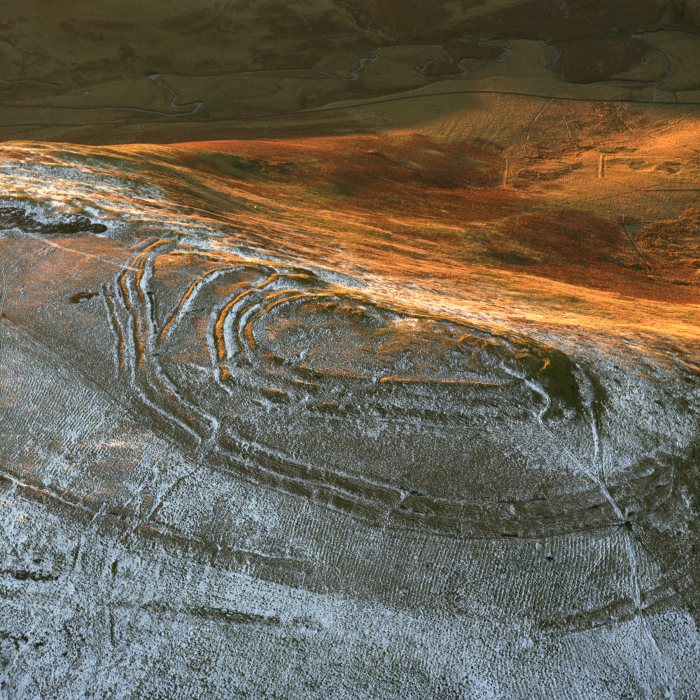
Woden Law submitted by dodomad on 8th Jan 2005. Aerial view of Woden Law fort, Scottish Borders. SC677288
Crown Copyright: RCAHMS
(View photo, vote or add a comment)
Log Text: Woden Law Hillfort, Scottish Borders: Firstly, congratulations are due to husband, Andrew, for getting me up onto this high, remote and very beautiful spot. The climb was certainly very worth it!
Driving back down from Dod Law/Chatto Hill, we arrived back at Pennymuir Roman Camps, turning left down the minor road passing Towford Outdoor Education Centre. Splashing through the ford through the wonderfully meandering Kale Water, we parked just before the t-junction a couple of hundred yards further on (there is room for 2 cars). Dere Street ran in both directions to our right hand side, doing a dog-leg past the camps and back up towards Trestle Cairn to the north-west, and running east-south-east, heading up into the gap between the hills of Hangingshaw Hill/Langside Law to the left with the impressive Woden Law to the right. Those Romans certainly knew a trick or two, as the road followed the lowest angle up the slope.
Setting off, I could hear a dog barking and eventually spotted two people descending the steep western slope of Woden Law with their three dogs. We kept to Dere Street.
At the top of the gap between the hills a small building was visible to the left of Dere Street, and heading towards this it was a slow, steady climb up easy grassy paths with the ditches of the road visible in parts. Just before reaching the building, at this point, it wasn’t clear if we could get through the newly built wire/barbed wire fence across the fields at this point(we've had problems of long stretches of fence lines with no gates before) so rather than go through the gate and follow the path, we trudged straight up the side of Woden Law which was rather steeper than it initially looked. I almost lost my nerve on this slope, having to step between tussocked lumps with holes in between. We soon reached the first bank and ditch of the Roman siege works on the lower slopes of the eastern side of the hill fort – but still about fifty feet below the summit. It became clear we should have kept to the path which was wide, grassy and easy walking!
Passing through a further set of fortifications, we reached the top of the hill. There was clearly a lot going on here – lumps and bumps and banks and ditches everywhere. Since coming home, we found the 1950 Excavation Report by the late Sir Ian Richmond and Professor St. Joseph, which has a plan of the fort in it. It would have been useful to have had this during our visit as we could have interpreted more of what we were seeing at the time, but has helped when cataloguing my photos. We started at the northern-most edge of the fort and worked our way over to the southern edge, taking note of the ramparts and structures on our way. At one point we noticed the rabbits had burrowed into the outer bank of the outer annexe and saw the high built up of turf on top of the stones used to create the wall.
The wind was persistent, and I was too much of wimp to go to the very edge of the fort, so Andrew took a few photographs perched on the outer bank.
Most definitely worth well the climb. Andrew wished he'd had his hang-glider.
Dodlaw Burn
Date Added: 26th May 2015
Site Type: Standing Stone (Menhir)
Country: Scotland (Scottish Borders)
Visited: Yes on 23rd May 2015. My rating: Condition 3 Ambience 4 Access 3

Dodlaw Burn submitted by Anne T on 26th May 2015. Standing behind the 'entrance pair' of stones looking west over the Kale Water valley.
(View photo, vote or add a comment)
Log Text: Dodlaw Burn Standing Stones and Cairns, Scottish Borders (alternative name = Chatto Hill Standing Stone): I guess we’ve become more than a little bit fascinated by this part of the Scottish Borders, probably because it’s easy to get to (about an hour from our house), there are very, very few people around (apart from the odd farmer and cyclist) and there are so many features/sites marked on the map.
Husband Andrew spotted an area marked on the map as having ‘standing stones and cairns’ relatively near to Woden Law hillfort, which we both wanted to see. So, on a sunny Saturday, we set off north.
Taking a different route from Jedburgh through Oxnam, we ended up back at the Pennymuir Roman Camps, continuing past them up towards Chatto Craig and Tronshaw Hill. The minor road passes over a cattle grid near Chatto/Upper Chatto, and immediately over the grid there is a sheep-fold with room for several cars to park without blocking access to the field.
A gate gives access onto the field from here and the track climbs up and off to the left hand side of the field, up past a small wood to the left hand side then levels off in the area between Dod Law hill to the right and Little Heuch Law to the left. Almost immediately, we were struck by what appeared to be cairns on the eastern flank of Dod Law and in the flat area to the left hand side of the track, what could possibly be a large hut circle and a cairn or two. Because of the depth of the tussocked grass, we could walk the bank of the ‘hut’ but couldn’t really capture it in a photograph. More research to done on the RCAHMS site in this area, me-thinks (there are lots of ‘dots’ on Canmore mapping here, but you can’t click on a dot and bring up the information, so it’s going to take some time). We did take grid references, and I’ll look at these when there is more time (and less gardening) to do. (Note: a subsequent look at the Canmore site reveals this circular feature is a most probably a sheepfold).
Continuing up the gently slope between the hills and crossing over the small ford over the Dod Law Burn, the standing stone appears on the brow of the hill just above you. Following the path, it becomes clear on reaching the top that there are three stones; two sit close together as a sort of entrance. The third sits low and flat to the ground to the east.
There are in fact three cairns to the north of the third stone, at grid references NT 77795 16810 (measures 5.6 metres in diameter, 0.4 metres high), NT 77800 16814 (immediately to the north east, 4 metres in diameter and 0.4 metres in height), and NT 77799 16820 (to the north, 4.6 metres in diameter and 1.5 metres in width). I’m glad we had the GPS device. None of the cairns could easily be photographed, but we could definitely see them with the naked eye. Whilst the 1999 record says they stand 0.4 metres above the land surface, I reckoned they were about 20 cms higher, probably because of the tussocks of grass around them. Thank goodness for having taken part in the Davy’s Lee Level 1 and Level 3 surveys recently, as I began to get my eye in to look at lumps and bumps and identify changes in grass height and colour, which gave clues as to the banks surrounding the cairns.
Above us to the east rose a cairn on Little Heuch Law.
The Ponteland Boulder
Date Added: 24th May 2015
Site Type: Rock Art
Country: England (Tyne and Wear)
Visited: Yes on 17th May 2015. My rating: Condition 3 Ambience 3 Access 5

The Ponteland Boulder submitted by Anne T on 18th May 2015. This recently discovered boulder sits in the gardens of the Great North Museum, to the right hand side of the access road which leads to the bank of bins at the rear door of the museum.
(View photo, vote or add a comment)
Log Text: The Ponteland Boulder, The Great North Museum, Newcastle-upon-Tyne: We'd been told about this boulder in March by one of guys at the Archaeological Group who is a very keen tracker of any new rock art found in the region. Then, strangely, it came up in Rock Articles which was emailled to me by Dr. Kate Sharpe at the University of Durham. Having been asked to look after our very young granddaughter for the day, plans for a long day out walking were truncated so we decided to head off into Newcastle and go searching for this boulder.
Walking through the University of Newcastle campus, we crossed Claremont Road and walked almost right round the museum and back again without spotting this stone. I was just about to head off into the museum to ask when my husband dived off into a small garden area fronting onto the main road, towards the bins. He came rushing back to tell me he'd found it.
Sited almost opposite the bank of big blue wheelie bins on the access road to the rear/delivery entrance to the museum wasn't maybe the best spot for this boulder, but here it was never-the-less.
There is obvious plough damage to the edges of the stone and it has been quarried at some point, making it originally much larger than it currently is.
The cup and ring motifs, particularly those at the edges of the boulder, had peck marks (like at Fowberry Park) next to them.
Definitely worth a visit if passing by. Note to those of you with families: at the far side of the museum, next to the car park, there is a large stone rhinoceros which is interesting to be photographed next to (but definitely not megalithic!).
Sewingshields Crags
Date Added: 8th May 2015
Site Type: Stone Row / Alignment
Country: England (Northumberland)
Visited: Yes on 8th May 2015. My rating: Condition 3 Ambience 4 Access 3
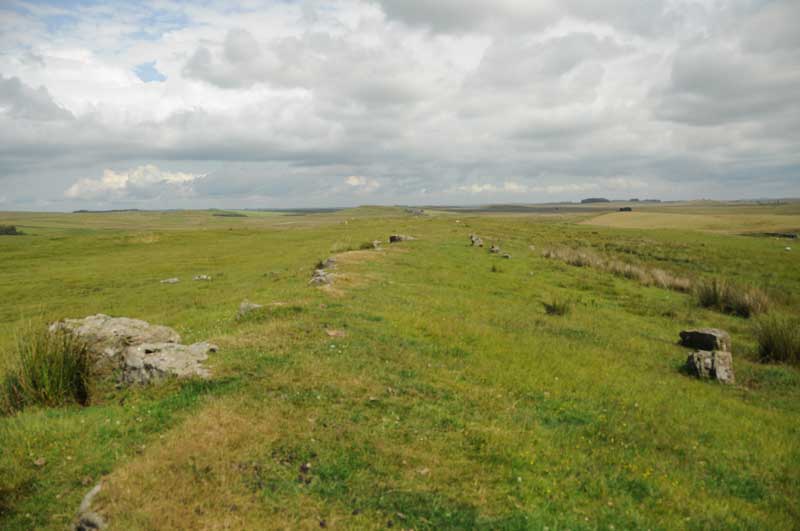
Sewingshields Crags submitted by Anne T on 8th May 2015. The boundary feature as it appears half way along its length, looking east.
(View photo, vote or add a comment)
Log Text: Sewingshields Crags Possible Stone Row, now known to be a boundary feature: I'm putting this on for completeness, as Andy B has added this as a site in it's own right; for my originalvisit report with more details, see Simonburn (Davy's Lee) Stone Circle visit report, 20th July 2014.
Having spotted a group of features on the map that looked interesting: Davy's Lee Settlement, Davy's Lee Stone Circle and various tumuli, we decided to take advantage of the sunshine and walk to this area. The previous weekend, we'd visited Standingstone Rigg, near Great Lonbrough Farm. If we had continued south along the footpath for a couple of kilometres from Standingstone Rigg, we would have reached Davy’s Lee from the north. Instead, we took the opposite approach, from the south, from the old military road (B6318). My husband parked the car by the Old Repeater Station (parking on the Old Military Road being sparse and difficult, with soft verges, lay-by's virtually non-existent and fast-flying cars driving up and down) having dropped me off at the farmhouse 100 yards west from this road junction, on the opposite side of the road, by the footpath up to Sewingshields and Sewingshields Crags. We’ve done this walk before, to see the Roman fishing loughs, but with this walk, we needed to follow the path nortwards past the farmhouses, round the back of Sewingshields Crags to the bottom of the hill, then turn off a track to the left hand side (approx. Grid reference: NY 80653 70820). The track disappears for a while, so we headed left up a bank with what looked like quarried stone at the top, running in a double row running approximately east to west (approx. Grid ref: NY 80393 70793).
Note: at the time of writing, I am going along to this area next week to help survey a group of stack-stands and/or sheilings (12th to 15th) so will have another look at this feature then.
Horseshoe Wood Settlement
Date Added: 24th May 2015
Site Type: Ancient Village or Settlement
Country: Scotland (Scottish Borders)
Visited: Yes on 4th May 2015. My rating: Condition 2 Ambience 4 Access 3
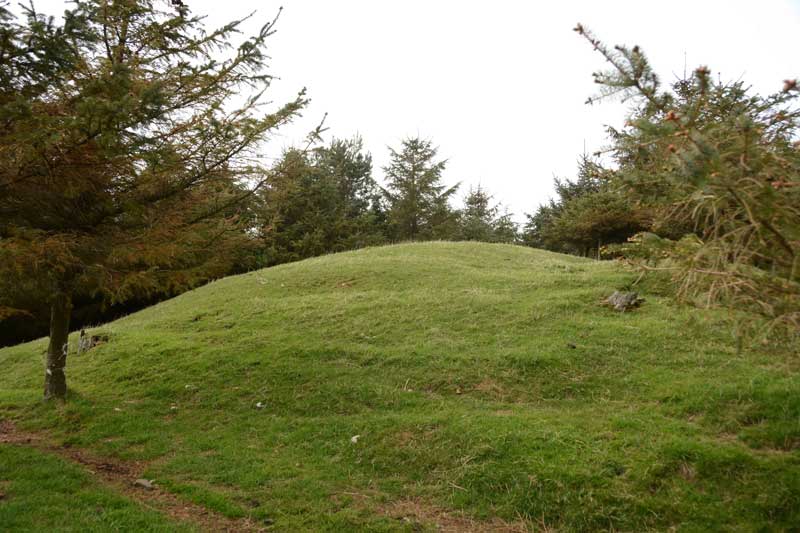
Horseshoe Wood Settlement submitted by Anne T on 9th May 2015. From a different angle the mound appears to have tiered banks which run around it (although always happy to be corrected as to what these features are).
(View photo, vote or add a comment)
Log Text: Horseshoe Wood Settlement, Hownam, Scottish Borders: After having parked in the sleepy little hamlet of Hownam, a footpath called The Street sets off near the village/community hall, leading off to the left of the main road up into the hills.
Just starting up The Street, there is a field to the right hand side of the road which holds what looks like another standing stone, so we stopped to investigate.
Continuing, we then passed a couple of houses on a gravelled roadway the footpath enters farmland which rises reasonably gently up towards Horseshoe Wood. At the time of our visit, the footpath was covered in manure (obviously had a herd of cattle on it recently). The lambs were very curious as to who these strangers were who were walking through their land, only moving from the warm soil of the path at the very last minute.
Horseshoe Wood runs to the left of the footpath, contained within a stone wall. Towards the higher end of the wood the wall has been demolished in two places and through this the mound of the settlement rises distinctly behind it.
Exploring, we found it to be an elongated mound, made even clearer by the fact it has no trees growing on it, with two circular scoops taken out of the left hand side; the first has a small tree growing out of it.
Curious, as this mound is relatively near the Standing Stone (only a couple of hundred metres), we took photographs and tried to find out more after our visit, but couldn't - but the description sounded identical to the RCAHMS/Canmore record of a scooped settlement nearby.
We thought perhaps this mound had been missed because it has been hidden by the wall and the trees within the wood.
If anyone can shed any further light on this mound, I'd be delighted to hear more.
Jedburgh Ancient Christian Stones
Date Added: 24th May 2015
Site Type: Ancient Cross
Country: Scotland (Scottish Borders)
Visited: Yes on 4th May 2015. My rating: Condition 3 Ambience 4 Access 5

Jedburgh Ancient Christian Stones submitted by Anne T on 8th May 2015. The impressive 8th century shrine with its intricate carvings, displayed on the first floor of the Visitor Centre adjacent to the Jedburgh Comb.
(View photo, vote or add a comment)
Log Text: Jedburgh Early Christian Stones: We've driven past Jedburgh, with the Abbey looming high on the hill to our left, on many an occasion but never stopped to take a closer look.
Turning left into Jedburgh, we were surprised to find that not only was the parking free, but there was free Wi-Fi throughout the town (although the password to connect varies as to the cafe/facility you are using at the time).
Paying the fee to get into the Abbey, we entered the Visitor Centre, and was astonished (and pleased) to find Anglo-Saxon cross fragments displayed on the walls of the stairwell and also on the first floor. These hadn't been mentioned on their website, and were definitely a nice bonus.
Having photographed the early Christian stones (including the wonderful 8th century shrine fragments) we made our way into the Abbey. I love looking at old monasteries and churches and really enjoyed our time here. It was sunny and warm, and we amused ourselves for a little while by trying to re-create a couple of the photographs in the guide book (almost, but not quite - I'm not that talented!).
No refreshments in the Abbey/Visitor Centre but a string of nice cafes opposite.
I would like to come back when the various museums are open. There is a lot to see in and around the town.
We cut the visit reasonably short as we wanted to head out into the hills to look at Standing Stones not too far away.
Would definitely recommend a visit.
Horseshoe Wood (Hownam)
Date Added: 24th May 2015
Site Type: Standing Stone (Menhir)
Country: Scotland (Scottish Borders)
Visited: Yes on 4th May 2015. My rating: Condition 3 Ambience 4 Access 3

Horseshoe Wood (Hownam) submitted by Anne T on 8th May 2015. One of the broader faces of this enigmatic standing stone in its gloriously scenic setting.
(View photo, vote or add a comment)
Log Text: Horseshoe Wood Standing Stone, Hownam, Scottish Borders: Note, when parking in the village and starting up The Street, in the field immediately to the right hand side of The Street, there appears to be what might be another standing stone or stones at grid reference NT 77991 19158. I coudn't find out anything about this apart from a brief mention on (dare I mention it! the Modern Antiquarian site).
From our parking spot in Hownam Village, The Street climbs slowly, steadily (and for the unfit, steeply!) up into the hills, although taken steadily it’s easy walking along a farm track. The views of the surrounding hills are impressive. Passing Horseshoe Wood with its possible settlement/mound, you turn the corner and see the standing stone sticking up out of a pair of banks to your right hand side.
There has obviously been modern quarrying nearby – the scars are visible with stones scattered around the area between the end of the wood and the standing stone. Ignoring these, this spot is beautiful with stunning views to the south.
The standing stone sits easily in the landscape on top of an elongated oval mound that we found has been scooped out at the far end – a quarry, or naturally shaped? My conclusion was that it was quarried in modern times, not very sympathetically.
The Canmore/RCAHMS notes say that in 1968 and 1979 this stone was leaning at an angle of 55 degrees. It is upright now, so has been re-seated at some time.
The Street continues up in between the Headshaw Law and Windy Law to your right and Hownam Rings to the left. Towards the top of the hill there is a signpost, and a left hand turn takes you towards The Shearers. Half way up the hill, to the right hand side of the track at grid reference NT 79015 19018 there is a reasonably sized boulder which sits on its own. For some reason I glanced at this rock and noticed an indentation. Looking more closely, I’m convinced this is a cup mark with a possible ring around it.
The Shearers
Date Added: 8th May 2015
Site Type: Stone Row / Alignment
Country: Scotland (Scottish Borders)
Visited: Yes on 4th May 2015. My rating: Condition 3 Ambience 4 Access 3
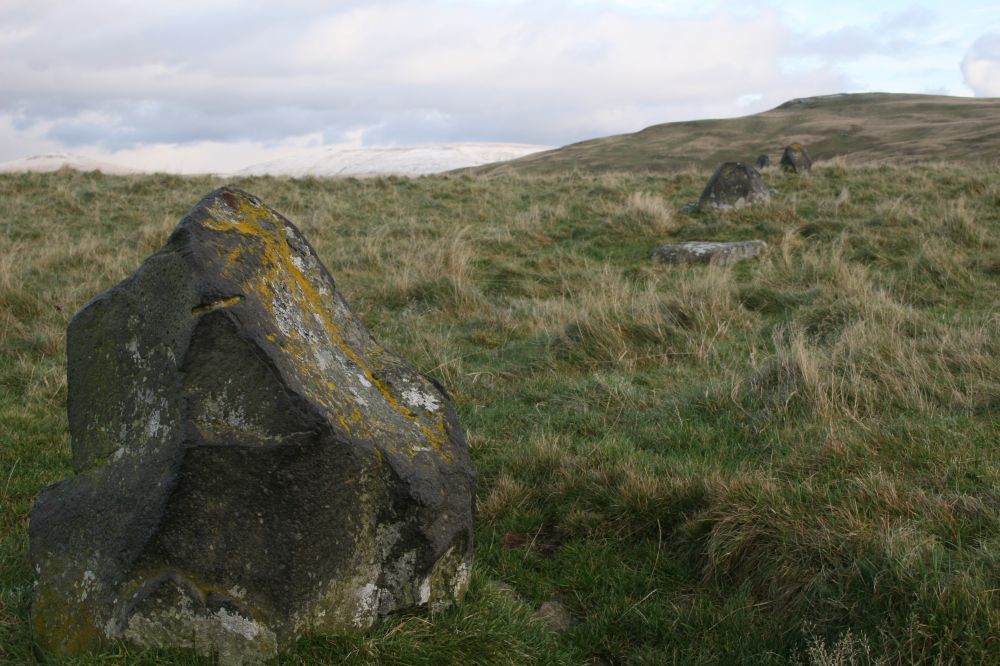
The Shearers submitted by minteddy on 18th May 2009. NT79101925. The Shearers. This view is looking east. Cheviot is the snow covered hill in the background. This photo was taken at the end of October 2008. The area is full of ancient remains, Roman roads and camps.
Five Stanes stone circle and Trestle cairn, the Roman Road of Dere Street are barely 5 km to the west. The path way up to the Shearers follows the line of the ancient track way "The Street" through the Cheviot Hills. It is truly a magical area. I love it.
(View photo, vote or add a comment)
Log Text: The Shearers Stone Row, near Hownam, Scottish Borders: Continuing on from the Horseshoe Wood Standing Stone, continuing up the hill, towards the top of the hill, but not quite, the pathway divides. To the left runs a path to Belford, with The Street leading to Alwinton.
Turning left towards The Shearers and Hownam Rings Hill Fort, we needed to go through two gates and track across the field rather than follow the signposted path. We noticed (more on the return journey due to the evening light) an earthwork. It was particularly evident near the two gateways by the signpost. According to the Canmore/RCAHMS record (341447) it is an earthwork of uncertain date, but very like the medieval estate boundaries we’ve been looking with the local archaeology group at Davy’s Lee in Northumberland.
There is no formal track across the tussocky grass, so the walking was a little trickier, but not impossible - there are plenty of sheep tracks to avoid turning your ankles. I saw at least three pairs of boulders in the grass leading from the Street to the Shearers – could these possibly be signposts to this monument, such as at the Loupin’ Stanes and the Girdle Stanes?
Standing in the middle of The Shearers it felt like being in the middle of a shallow bowl with a view only to the west. Following the row to its western end, it appeared to end in a boggy area – was this deliberate?
Hownam Rings Hill Fort was only 100 metres to the north and clearly visible above the Shearers.
St Patrick's Well (Aspatria)
Date Added: 4th May 2015
Site Type: Holy Well or Sacred Spring
Country: England (Cumbria)
Visited: Yes on 1st May 2015. My rating: Condition 4 Ambience 3 Access 4
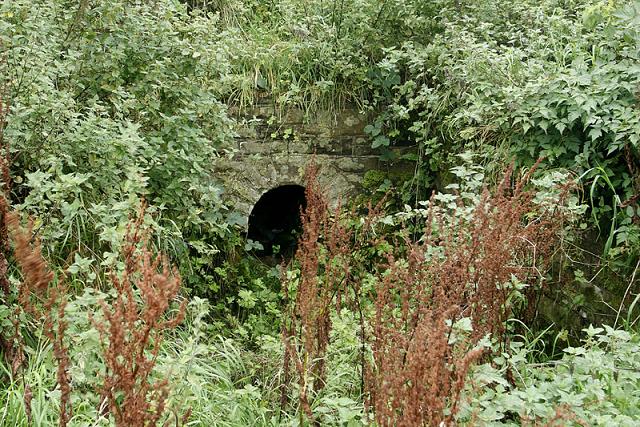
St Patrick's Well (Aspatria) submitted by MisterBus on 25th Sep 2010. St Patrick's Well, Aspatria, Cumbria UK. The well is at the rear of the church in the graveyard. Although the graveyard is well cared for the area around the well is overgrown and in much need of restoration.
(View photo, vote or add a comment)
Log Text: St Patrick's Well, Aspatria. This well can be found in the churchyard of St. Kentigern's Church at Aspatria. Driving into Aspatria along the A596 from Carlisle, the church is on the right hand side of the road with disk parking on both sides of the road. There are steps up from the gate into the churchyard.
We arrived during the annual church flower festival (1st to 4th May). Before going into St. Kentigern’s Church to see the Anglo Saxon Cross and Viking Hogback Tombstone, we’d had a quick scout around the churchyard to see if we could see the well, but no. Asking directions from one of the guides at the church, he told us to “go out of the west door, turn right and it’s 50 yards down – you can’t miss it. Following his directions, where the path around the church turned along the northern corner, all we could see were gravestones and a fenced off area containing shrubs. The path stopped at this point and we had to make our way over the grass, avoiding the humps and bumps of grass-covered graves. Once at the fenced off area and having turned the corner, we saw immediately where the well was, contained within a neat, modern-looking stone walls with a path leading up to it.
The well was dry at the time of our visit, and looked as it if had been for some time. It wasn’t obvious where the water went to – it must have formed a small pool within the confines of the paved area, any overspill running onto the grass beyond. Whilst the well was said to have been used by St. Kentigern for baptisms, I didn’t find it had any atmosphere at all. The Pastcape record (id=9583) says that “The feature consists of a short path, steps, and the rectangular enclosure of a spring, all of Victorian construction. The vicar confirmed the name as St. Patrick's Well but there are no records of a pre-19thc structure, only of a natural spring."
There was a good view of the Anglo Saxon cross at the east end of the church from here, together with the dovecot – the most original and complete of its kind in Cumbria.
Note: St. Kentigern was also known as St. Mungo (meaning ‘dear one’). According tothe church guide booklet, he was “rescued with his mother from a drifting coracle on the Firth of Forth .... was taken into the monastery at Culross in Fife .... The people of Strathclyde revered him for his holiness of life and chose him as a bishop, but in a time of political disorder, he fled south, possibly to Wales. It is believed that on his travels he found the area which is now northern Cumbria to be unevangelised, and the dozen or so churches dedicted to Kentigern or Mungo are thought to have been founded as the result of his preaching.” Kentigern or Mungo is the Patron Saint of Glasgow.
St Bridget's Church (Bridekirk)
Date Added: 9th May 2015
Site Type: Ancient Cross
Country: England (Cumbria)
Visited: Yes on 1st May 2015. My rating: Condition 2 Ambience 4 Access 5
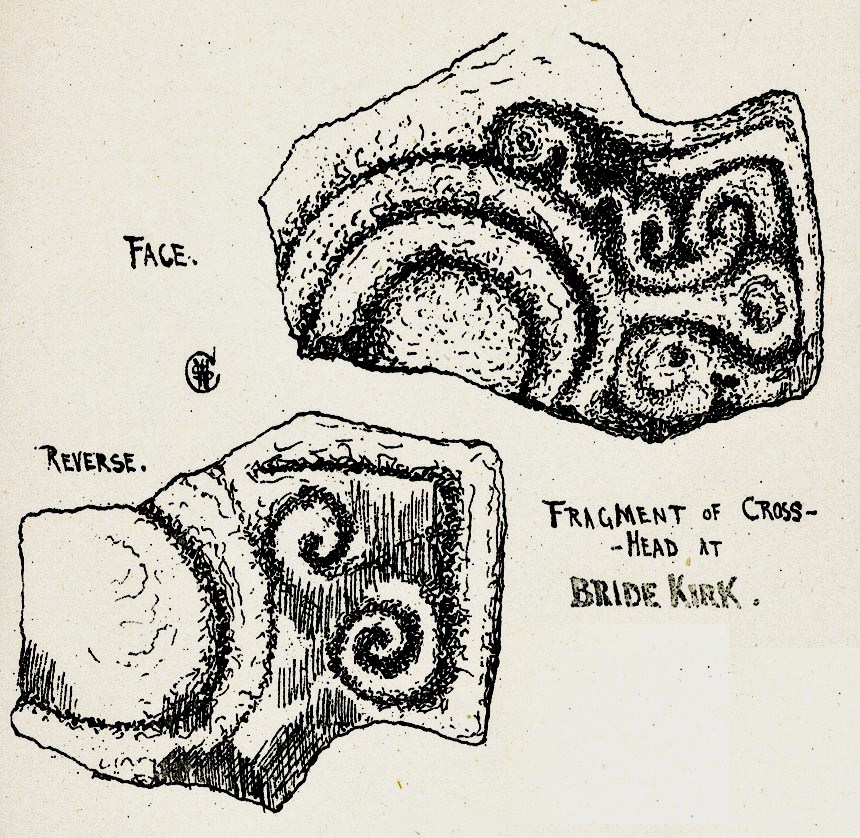
St Bridget's Church (Bridekirk) submitted by Sunny100 on 19th Apr 2011. Illustration of The Cross-Head fragment at St Bridget's Church, Bridekirk, Cumbria, by Rev William Slater Calverley 1847-98.
The above image is from his renowned work 'Early Sculptured Crosses, Shrines and Monuments in the Present Diocese of Carlisle 1899 Ed. by W.G. Collingwood.
(View photo, vote or add a comment)
Log Text: Anglo Scandinavian Cross Arm Piece, St Bridget's Church (Bridekirk): We arrived here just after 4pm. I’m not sure what I expected, but the old church was an enigmatic ruin at the eastern end of the churchyard – no more than a few ivy covered walls left of the chancel with graves contained within.
This church is usually open from morning until dusk. We went into the church and admired the ancient font. We found the remains of the Anglo Scandanavian cross head on the window sill on the north wall and I photographed it, turned it round and photographed the other side. [The Corpus of Anglo Saxon Stone Sculpture web site was off-offline when we visited, but their reference for this stone is Bridekirk 01. The smaller fragment of cable roll moulding to the right hand side of this piece is ref. Bridekirk 02.]
There was also a carved stone piece on a window ledge opposite, on the south wall. The guide describes this as “Opinions differ about the origins of the stone on the opposite windowsill (which was found in the churchyard in 1911) between being part of a Romanesque carved panel, or a genuine piece of Roman sculpture. Those who have claimed it to be Roman consider it to be a dedication to the Romano-British water goddess Coventina”.
As we were walking into the chancel, the door opened and a voice said ‘hello, do you want some lights on?’. The church warden had come down to lock up. Our visit was a little curtailed as she kindly chatted to us throughout, telling us about the old church and that there was thought to be the remains of an older wooden structure underneath.
Because we were now being accompanied, we missed quite a few features we’d really rather have stayed to see. I didn’t really get to appreciate the door into the south transept, which was relocated from the original old church; the arch over the organ in the north transept is also from the old church. There is also in the porch an ancient piece of red sandstone which dates from the 11th or 13th centuries depicting the head of Christ.
Next to the ruined Norman chancel, there is also a modern version of an Anglo-Saxon cross used as a grave marker which dates from 1892. Worth a re-visit when we're next passing.
Ireby Old Church
Date Added: 9th May 2015
Site Type: Ancient Cross
Country: England (Cumbria)
Visited: Yes on 1st May 2015. My rating: Condition 3 Ambience 4 Access 4
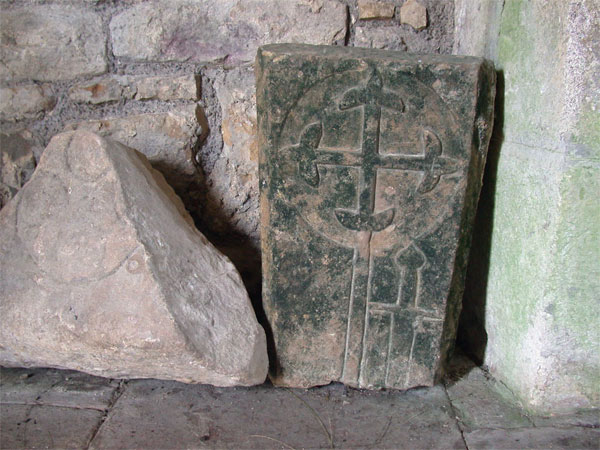
Ireby Old Church submitted by nicoladidsbury on 11th Feb 2005. Carvings inside the church
(View photo, vote or add a comment)
Log Text: Anglo Saxon Cross, Old Chancel, Ireby: Travelling from Bridekirk back towards Carlisle, we took the minor road through Torpenhow (couldn’t spot the pub marked on the map, which would have been a welcome stop at this time of day). Just leaving the village a sign told us the road wasn’t suitable for HGV’s – it was very narrow in parts but not that bad. Funny that the church, although in the care of the Churches Conservation Trust, wasn’t signposted, although it was easily visible across the field to our right hand side. We ended up turning right down the track to New Park farm and parked about 100 yards down on the right hand side at by a gate just past the stream called ‘Church Strand’.
With 5 month old granddaughter in arms (no chance of taking her pushchair) we opened the gate rather than climb over the stile, and walked across the little wooden footbridge over the stream and the 100 yards or so across the picturesque field to the church. Also funny that we had to navigate the paved drain to the south side of the church to enter at the west door as there wasn’t a footpath!
It was cold and damp inside the church, although the internal features more than made up for this. Just made up of the one room, rows of narrow wooden trestles (how uncomfortable to sit on during long sermons) lined either side of the aisle. A narrow table served as the altar. Windows in the south side of the church had been blocked up, although there was no sign of these in the external wall of the church. The pillars which had been relocated in the churchyard were odd and interesting, as was the incised tynpanum over the west door.
We searched for the various bits in the church. There was no church guide to bring away – we took photographs of the CCT sheet left for visitors to use.
As usual, I poked around the overgrown graveyard for unusual grave stones. We didn’t find the two cross bases mentioned in the Portal notes.
A very unusual little church, well worth the visit. I'm keen to revisit without infants and in the autumn when the grass and nettles will have died back so we might be able to find those cross bases.
At the time of writing the Corpus of Anglo Saxon Stone Sculpture website appears to be down so I haven’t been able to check any details of the crosses - I'm keen to find out more. [Note: I've since found this church is not included on their web-site].
St Kentigern (Aspatria)
Date Added: 5th May 2015
Site Type: Ancient Cross
Country: England (Cumbria)
Visited: Yes on 1st May 2015. My rating: Condition 3 Ambience 4 Access 5
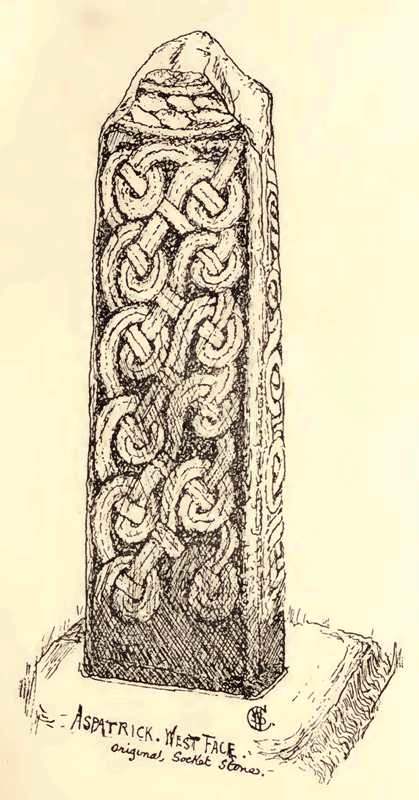
St Kentigern (Aspatria) submitted by durhamnature on 11th Sep 2012. Cross of St Kentigern, Aspatria, from "Early Sculptured Crosses...in the Diocese of Carlisle", 1899, via internet.org
(View photo, vote or add a comment)
Log Text: Anglo Norse Crosses and a Viking Hogback, St Kentigern's Church, Aspatria: Following the A596, signposted to Aspatria, the church is on the right hand side as you drive into the village, set above the road and separated from it from a stone wall.
Parking in a one hour disk parking spot just outside the church, we noticed straight away a tall cross standing at the exterior east end of the church and went straight round to photograph it [according to Wikepedia http://en.wikipedia.org/wiki/Gosforth_Cross “In 1887, the Rev. William Slater Calverley commissioned a replica life-sized copy of this cross and erected it in the churchyard at Aspatria, Cumbria.“ There was also a collection of artefacts with what looked like parts of two Anglo Saxon Cross heads built into the wall.
There was a church festival, with flowers, fairy lights and candles, lots of regular church-goers helping out and many other visitors popping in, so with my camera and flashgun, I felt a bit as if we were intruding.
Enterging the church from the west doorway through the porch, we literally had to walk round another cross at the west end of the church. I asked if it was OK to take photographs using the flash it is was in relative darkness on its western side; the surrounding displays made it a little challenging to take photographs although one of the gentlemen helpers offered to move the flower stand they were using to hold leaflets for visitors, which made it easier.
There was another table with all sorts of reading material displayed on it, including a browning newspaper article saying the cross outside was a copy of the Gosforth Cross [whilst the shape was similar, I questioned whether or not the carving was the same – I’ll need to compare the photographs].
The guide then pointed us in the direction of the unusual and lovely 13th century font and told us there was part of a Viking Hogback displayed. The carvings were intricate. The church guide told me this stone was “found amongst the building material of the Norman church”.
A quick walk around the rest of the flower displays followed, especially as we ended up blocking the aisles with our small granddaughter’s pushchair and no-one could get past! As a result, we missed some of the other crosses within the building, particularly those in the vestry, but we’ll go back again when the festival isn’t on and we can wander around more freely. According to the Pastscape record there is another cross (sans top) 40 yards south of the church.
With directions from one of the guides in the church, we walked to the north side of the church yard to find St. Patrick’s Well.
Falla Knowe Cairn
Date Added: 24th Apr 2015
Site Type: Cairn
Country: Scotland (Scottish Borders)
Visited: Saw from a distance on 23rd Apr 2015. My rating: Access 4

Falla Knowe Cairn submitted by durhamnature on 3rd Oct 2012. Cross-section drawing from Berwickshire Naturalists via archive.org, showing location of urn and flint scraper.
Site in Scottish Borders Scotland
(View photo, vote or add a comment)
Log Text: Falla Knowe Cairn, Scottish Borders: Not quite the actual Falla Knowe robbed out cairn, but one nearby.
Travelling up Dere Street, having parked next to Pennymuir Roman Camp A just across the road from this section of the Roman Road, we made our way north up this deeply rutted section of the footpath towards Black Knowe and Trestle Cairns (wellies will be needed after wet weather - it was bad enough after a dry spell). Whilst there were a number of cairns, settlements and earthworks marked on the map in the field to our left, it was difficult to make out any features amongst the tussocks of grass and heather. The forest marked on the map immediately after the road has now been cut down, leaving large stumps sticking up out of the ground like ancient teeth.
We did notice that the corner of the stone wall/dyke and wooden fence post was placed almost dead centre of a circular raised mound. Whilst this cairn is marked on the Canmore Mapping for RCAHMS site 58154 no details are given. Grid reference for this cairn is NT 75204 14973.
